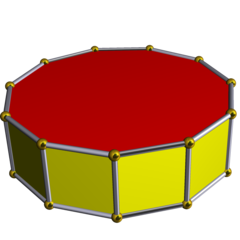Hendecagonal prism
Appearance
| Uniform hendecagonal prism | |
|---|---|

| |
| Type | Prismatic uniform polyhedron |
| Elements | F = 13, E = 33 V = 22 (χ = 2) |
| Faces by sides | 11{4}+2{11} |
| Schläfli symbol | t{2,11} or {11}×{} |
| Wythoff symbol | 2 11 | 2 |
| Coxeter diagram | |
| Symmetry group | D11h, [11,2], (*11.2.2), order 44 |
| Rotation group | D11, [11,2]+, (11.2.2), order 22 |
| References | U76(i) |
| Dual | Hendecagonal dipyramid |
| Properties | convex |
 Vertex figure 4.4.11 | |
In geometry, the hendecagonal prism is one in an infinite set of convex prisms formed by square sides and two regular polygon caps, in this case two hendecagons. So, it has 2 hendecagons and 11 squares as its faces.
Related polyhedra
| Family of uniform n-gonal prisms | |||||||||||||
|---|---|---|---|---|---|---|---|---|---|---|---|---|---|
| Prism name | Digonal prism | (Trigonal) Triangular prism |
(Tetragonal) Square prism |
Pentagonal prism | Hexagonal prism | Heptagonal prism | Octagonal prism | Enneagonal prism | Decagonal prism | Hendecagonal prism | Dodecagonal prism | ... | Apeirogonal prism |
| Polyhedron image | ... | ||||||||||||
| Spherical tiling image | Plane tiling image | ||||||||||||
| Vertex config. | 2.4.4 | 3.4.4 | 4.4.4 | 5.4.4 | 6.4.4 | 7.4.4 | 8.4.4 | 9.4.4 | 10.4.4 | 11.4.4 | 12.4.4 | ... | ∞.4.4 |
| Coxeter diagram | ... | ||||||||||||
